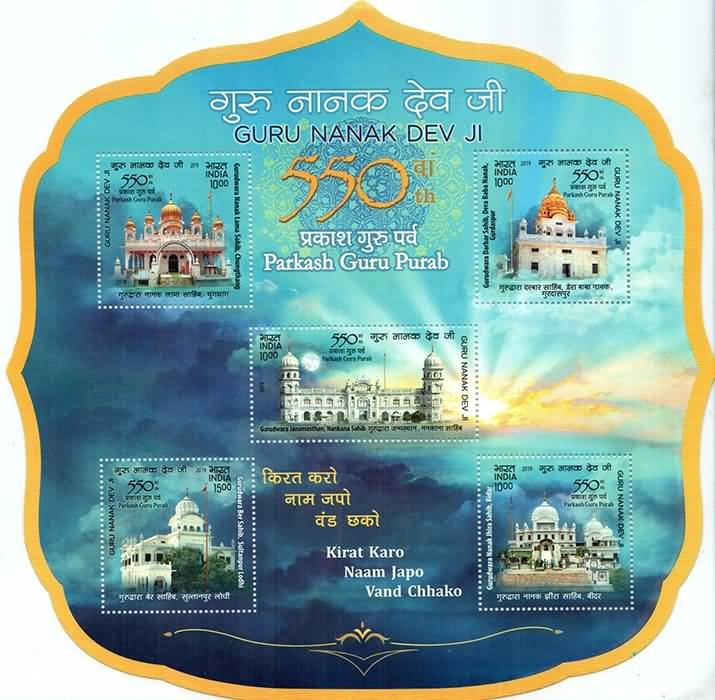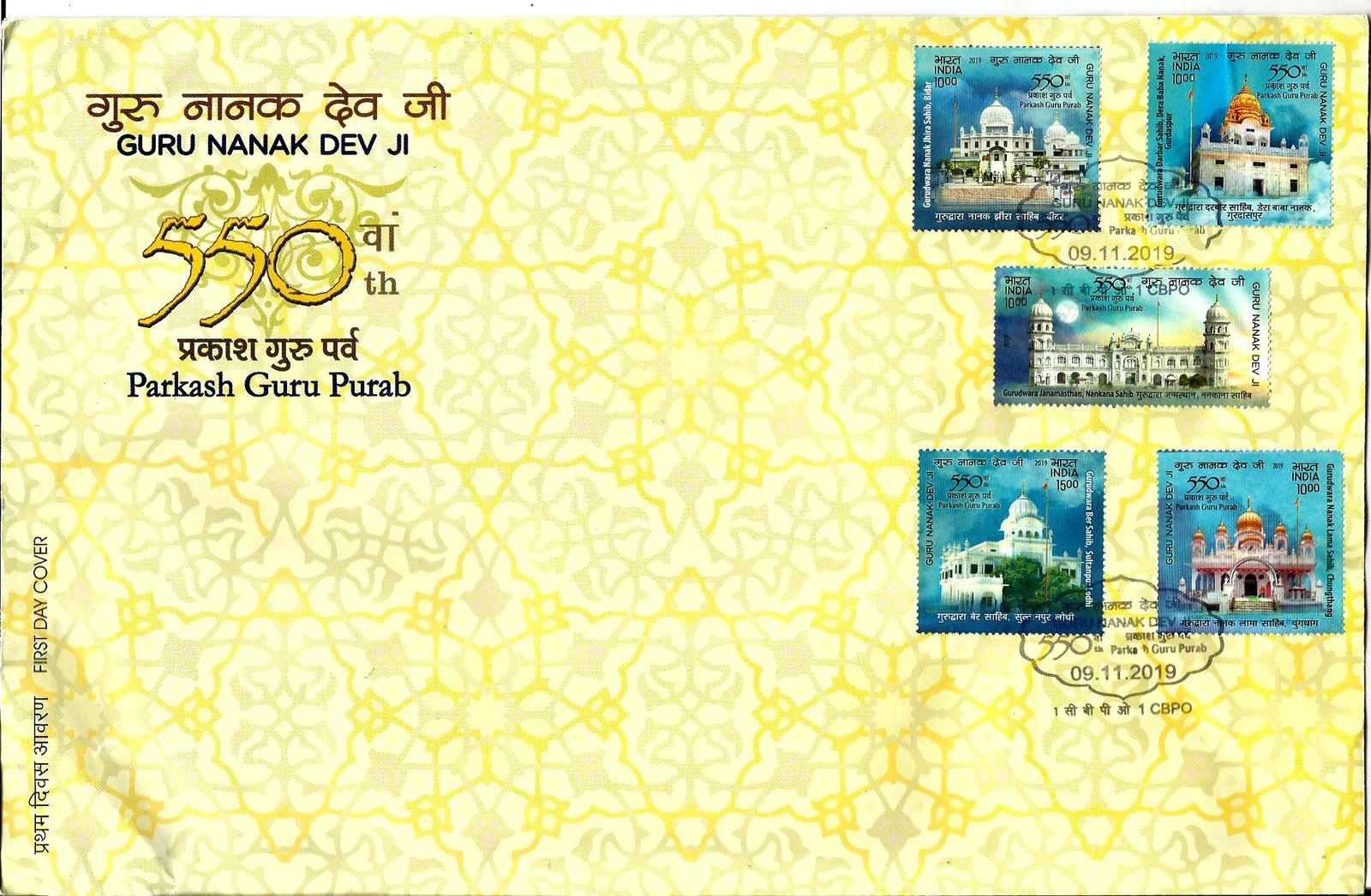Guru Nanak Dev Ji, 550th Birth Anniversary

Technical Data
| Date of Issue | November 9, 2019 |
|---|---|
| Denomination | Rs. 55 |
| Quantity | 110,000 |
| Perforation | 14¼ x 14¼ |
| Printer | Security Printing Press, Hyderabad |
| Printing Process | Wet Offset |
| Watermark | No Watermark |
| Colors | Multicolor |
| Credit (Designed By) | Sh. Pallab Bose Shri Kamleshwar Singh Smt. Alka Sharma |
| Catalog Codes |
Michel IN BL224 Stamp Number IN 3177a Yvert et Tellier IN BF210 Stanley Gibbons IN MS3691 |
| Themes | Anniversaries and Jubilees | Religion | Temples |
The Eternal Light of Sikhism
Guru Nanak Dev Ji (1469–1539), the founder of Sikhism and the first of the ten Sikh Gurus, was a spiritual reformer and messenger of divine truth. His teachings emphasized the oneness of God, equality of all human beings, and the importance of truthful living and compassion. His birth is celebrated across the world as Guru Nanak Guru Purab or Kartik Poornamashi, observed on the full-moon day in the month of Kartik (October–November).
Guru Nanak travelled extensively across India and beyond during his Udasis (spiritual journeys) to spread his universal message of love, humility, and devotion. His teachings are immortalized in 974 poetic hymns compiled in the Guru Granth Sahib, the sacred scripture of Sikhism.
To commemorate the 550ᵗʰ Birth Anniversary of Guru Nanak Dev Ji, India Post issued a set of five Commemorative Postage Stamps, each featuring a sacred Gurdwara associated with significant moments from his life. These holy sites, located across India and Pakistan, continue to inspire millions with their spiritual and historical significance.
1. Gurudwara Nanak Lama Sahib, Chungthang (Sikkim)
Nestled in the Himalayas at Chungthang, North Sikkim, at an altitude of nearly 18,000 feet, Gurudwara Nanak Lama Sahib is a beautiful and serene shrine managed by the Indian Army.
Guru Nanak visited this place during his fourth Udasi (journey) while returning from Tibet. Legend says that the Guru blessed the barren land by scattering a handful of paddy, and since then, Chungthang remains the only place in the region where paddy grows. Another legend narrates how he touched the frozen Guru Dongmar Lake with his stick, melting the ice and blessing it with perpetual, unfrozen water.
Located at the confluence of the Lachan and Lachung Chu rivers, the Gurdwara’s design beautifully combines traditional Sikh architecture with Tibetan monastic influences, symbolizing peace and harmony amidst the Himalayas.
2. Gurudwara Darbar Sahib, Dera Baba Nanak (Gurdaspur, Punjab)
Situated on the banks of River Ravi, Gurudwara Darbar Sahib marks the place where Guru Nanak Dev Ji spent his final years at Kartarpur, now in Pakistan. The town of Dera Baba Nanak was established by his descendants, the Bedis, in his honour.
Pilgrims visit this sacred site in large numbers to pay homage and view Kartarpur Sahib across the international border. Guru Nanak came here in 1515 AD after his first Udasi to reunite with his family.
In November 2019, the Kartarpur Corridor was inaugurated, connecting Dera Baba Nanak in India with Gurudwara Darbar Sahib Kartarpur in Pakistan, symbolizing peace, unity, and the spirit of devotion.
3. Gurudwara Janamasthan, Nankana Sahib (Pakistan)
Located in the city of Nankana Sahib near Lahore, this Gurdwara marks the birthplace of Guru Nanak Dev Ji. Built at the site where he was born to Mehta Kalu and Mata Tripta, it stands as one of the holiest Sikh shrines.
The first shrine was built in the 16th century by his grandson, Baba Dharam Chand, and later reconstructed by Maharaja Ranjit Singh in the 19th century. The grand complex features a domed sanctum, a rectangular pavilion, and a vast walled courtyard that welcomes pilgrims from across the world.
Today, Gurudwara Nankana Sahib forms part of an ensemble of nine historical shrines in the region, making it a central point of Sikh pilgrimage.
4. Gurudwara Ber Sahib, Sultanpur Lodhi (Punjab)
Located on the banks of the rivulet Kali Bein, Gurudwara Ber Sahib marks the place where Guru Nanak Dev Ji attained enlightenment. He would meditate under a Ber (Zizyphus) tree for over 14 years.
Built by Maharaja Jagatjit Singh of Kapurthala, the Gurdwara stands on a high plinth, with Gothic arches, octagonal columns, and intricate floral stucco designs. The Guru Granth Sahib is placed in a marble sanctum, adding to the shrine’s divine aura.
Every November, thousands of devotees gather here for the Guru Nanak Jayanti fair, celebrating the Guru’s birth and his teachings. Sultanpur Lodhi served as the nerve centre for the 550ᵗʰ Birth Anniversary celebrations, reinforcing its timeless spiritual importance.
5. Gurudwara Nanak Jhira Sahib, Bidar (Karnataka)
One of South India’s most revered Sikh shrines, Gurudwara Nanak Jhira Sahib was built in 1948, surrounded by lush gardens and hills in Bidar.
According to legend, during Guru Nanak’s visit, the people of Bidar faced acute water scarcity. The Guru struck a rock with his foot, and fresh sweet water began to flow from it — a stream that continues to this day. The word “Jhira” means a natural spring, symbolizing divine grace and sustenance.
The Gurdwara complex houses the Guru Granth Sahib, a Langar Hall, and Diwan Hall, serving as a centre of faith, service, and community for Sikhs across southern India.
A Tribute Through Philately
India Post’s commemorative stamp set celebrating the 550ᵗʰ Birth Anniversary of Guru Nanak Dev Ji beautifully captures the spiritual geography of Sikhism — from the Himalayas of Sikkim to the plains of Punjab and the hills of Karnataka.
Each stamp honours the life, travels, and teachings of Guru Nanak, serving as a lasting tribute to his message of oneness, humility, and divine truth — values that continue to guide humanity across centuries.
First Day Cover

